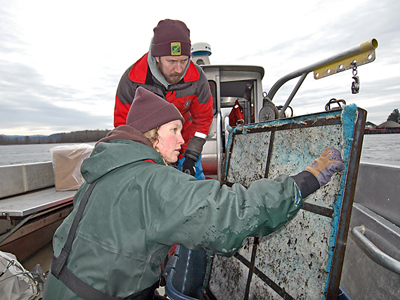Oregon DFW Research Targets Columbia Eulachon
OutdoorHub 04.11.12

They are among the smallest, least understood, and yet most important fish in the Columbia River and its tributaries.

Eulachons, better known as smelt, appear to be returning in stronger numbers the last two years than in the recent past, although they are still listed as threatened under the federal Endangered Species Act (ESA) and, as such, are off limits to fishing.
Following a relatively large run in the Cowlitz River on the Washington side of the Columbia this year, the Oregon Department of Fish and Wildlife is expecting smelt could show up in the Sandy River. In anticipation of the fish’s arrival, usually in the spring, the department posted signs along the lower reaches of the Sandy reminding anglers that smelt fishing seasons remain closed.
“We want to make sure people remember that smelt are now protected and need to be left alone,” said Danette Faucera, assistant fish biologist for the Oregon Department of Fish and Wildlife. “Smelt arrive in waves, and in the past when one was seen in the Sandy River within hours lots of people were fishing for them. We want to make sure that doesn’t happen if the smelt show up in the Sandy this year.”
Once so abundant they were caught by the bucket load with dip nets, eulachon numbers have dropped precipitously since the 1940s when they entered the Columbia in such large numbers they literally choked tributaries like the Cowlitz and Sandy river with tremendous silvery schools of migrating fish. Their ability to reproduce in large numbers – one 6- to 8-inch adult female can produce up to 40,000 eggs – is crucial to their survival since they are prey for many other species, including humans.
Since NOAA Fisheries listed eulachons for protection under the ESA on May 17, 2010, biologists have begun taking a closer look at them and what it will take to protect the species. This task is more complicated now that sport and commercial seasons are closed. Those fisheries were valuable to researchers because they provided population indicators that scientists used to monitor and track trends in eulachon abundance.
“With the close of smelt fisheries we lost a tool that has been used to follow abundance trends for decades,” said Tom Rien, ODFW’s Columbia River Coordination Program manager. “So we must now use other monitoring to track trends in abundance.”
Biologists are now generating population estimates by measuring smelt eggs and larvae, which are collected at multiple points along the Columbia River from Bonneville dam downstream 105 miles to Westport. Twice a week, an ODFW research vessel moves up and down the river lowering and raising a fine mesh net shaped like an airport wind sock to collect eggs and larvae that are virtually invisible to the naked eye. ODFW researchers also retrieve eggs from fibrous mats laid out on the bottom of the river. The mats, which look like furnace filters, are designed to catch the microscopic eggs as they settle on the river bottom. Tethered to bright orange buoys, the mats are pulled from the river floor onto the research boat and flushed with river water to wash the eggs into containers that can be taken back to the lab for analysis under a microscope.
Oregon’s work is concentrated on the eulachon’s use of upstream habitat. When researchers find larvae in the water they know spawning occurred upstream from that area.
In cooperation with Washington Department of Fish and Wildlife staff, ODFW researchers are trying to identify critical habitats, reproductive success, timing and other factors in the main stem Columbia River, according to Erick VanDyke, ODFW eulachon fisheries project leader.
“Smelt are a pivotal species in the Columbia River,” said VanDyke. “They sustained Native American populations during the winter and are forage for many animals.”
The Cowlitz Tribe, which originally filed the petition asking the federal government to list smelt under the ESA, is also cooperating in smelt research. Its efforts are focused in the Cowlitz River, where it conducted a test fishery this year and confirmed the presence of a relatively large run of eulachons. Cowlitz tribal biologists are also conducting research in the Sandy River in cooperation with ODFW and NOAA Fisheries.
Scientists agree that smelt are important, although eulachons are less extensively researched than other inhabitants of Columbia River waters. Scientists don’t know, for example, how smelt find their way back from the ocean, what kind of habitat they need or why returns can be very small one year and quite large the next.
With their listing under the ESA more attention will be focused on smelt in the years ahead as state, federal and tribal fisheries managers develop a recovery plan for Pacific eulachon.
Commercial and recreational smelt fishing may return to the region someday but probably not before a team of federal, state and tribal biologists develop an approved smelt recovery plan. The plan will likely address not only sport and commercial fishing but other activities that could impact the fish as well, including dredging and hydroelectric facilities.
There is a lot to learn about how, where and when smelt use the Columbia River and tributary habitats. Smelt use the same migration corridors and some of the same spawning and rearing habitats that sustain salmon, steelhead, and sturgeon. Efforts to understand and protect these important areas should benefit all native species, according to Rien.

